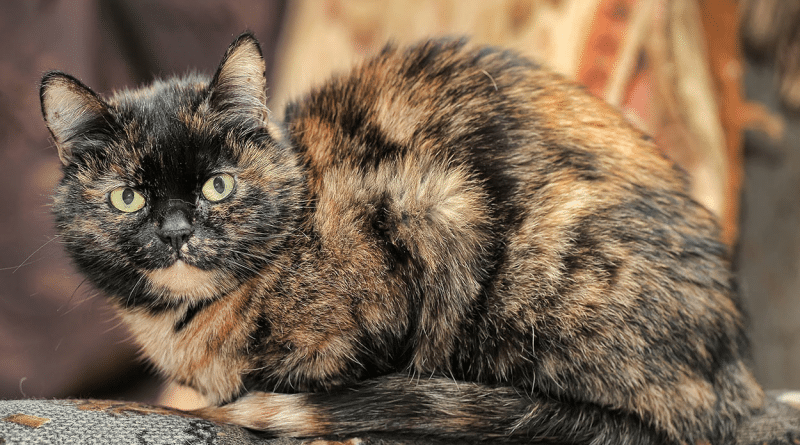Last Updated on July 2, 2021 by Fumipets
Tortoiseshell cats are called so because their bi-coloured coats have the appearance of the shell of a tortoise, which is what they resemble. Torties, as they are affectionately known, are brightly coloured cats that are popular as pets in many households. It is typically the first thing that people notice about your cat when they see it since it has such an intriguing and distinctive coat. Many people are puzzled as to how they came to have such beautiful marks on their bodies.
Tortoiseshell cats, like calico cats, have some intriguing genetics, and they’ve become popular figures in mythology all across the globe, particularly in the United Kingdom. Because of a variety of genetic abnormalities, their coats grow with patterns that are nearly marbled in appearance. Whether you’re thinking of adopting a tortoiseshell cat or simply want to learn more about these lively and energetic cats, the information and pictures in this article are guaranteed to entice you to do so.

Tortoiseshell Isn’t a Breed
The patterned coat of a tortoiseshell is what distinguishes it from other breeds, not the breed itself. There is no such thing as a tortoiseshell breed of cat in the real world. Some breeds, including American shorthair and British shorthair as well as the Cornish Rex, Persian, and Maine Coons, may show tortoiseshell markings, although this is not always the case.
Tortoiseshell coats are most often seen in ginger red and black, although they may also be seen with touches of cream, orange, or gold in the design. The colours in their coats are either “bridled,” which gives the appearance that they are braided together, or “patched,” which means that the colours create huge patches all over their bodies.
Most Tortoiseshell Cats Are Female and Males Are Extremely Rare
You will discover that most tortoiseshell cats are female, just as you will find with calico cats. This is due to the fact that the same chromosomes that determine their gender also control the colour of their coats.
The genetic coding for orange or black coat colours is also carried by the female sex chromosome (X), while the male sex chromosome (Y) does not contain any information about coat colour at all.
Given that females have two sets of X chromosomes, they have two sets of genetic information that may be used to determine the colour of their fur coat. The embryo disables one X chromosome in each cell, resulting in coats that are orange or black in colour depending on the stage of development.
Male cats are only orange or black because they have one X chromosome and one Y chromosome, and they cannot be both at the same time.
A male tortoiseshell cat may be born with two X chromosomes and one Y chromosome under very uncommon circumstances (about 1 in 3,000). The unfortunate reality is that male torties with XXY Syndrome are infertile and often suffer from severe health problems, leading in considerably shorter lives than their female counterparts.

Torties Have a Distinct Temperament
Tortoiseshell cats do not belong to a particular breed, although some people think they have a distinct personality.
In a study performed by the University of California, Davis Veterinary Medical Teaching Hospital, researchers looked at the relationship between the colour of a domestic cat’s coat and the behaviour of the cat. Specifically, tortoiseshell cats (together with calicos and “torbies”) were the subject of the research.
Following the publication of the research, it became well known that tortoiseshell cats had a unique, if not a little sassy temperament, which was soon dubbed “tortitude.” As anecdotal evidence suggests, many tortie owners felt that their cats were high-energy, feisty, and even a little violent.
Nonetheless, according to the study’s findings, the researchers did not discover any significant relationship between coat colour and behaviour, temperament, or personality.
Perhaps the term “tortiude” was simply mistaken with the more common term “catitude.”
Tortoiseshell Cats Are Considered Good Luck All Over the World
Tortoiseshell cats are associated with good fortune in a number of cultures.
According to Southeast Asian mythology, tortoiseshell cats were created from the blood of a young goddess who was sacrificed to the gods.
Tortoiseshell cats are thought to have the ability to guard their owners’ homes from ghosts in Japan.
According to English tradition, stroking the tail of a tortoiseshell cat on a wart would heal the ailment.
Tortoiseshell cats are considered to be “money cats” in the United States, and they are thought to bring good fortune into the house of their owners.

They’re Named After Tortoiseshell Material
Prior to the 1970s, tortoiseshell (made from actual, live tortoises) was considered a very high-end material, and it was used to make jewellery, eyeglasses, and other home décor items. Tortoiseshell cats were called after this substance because their coats include hues and patterns that are evocative of the material.
Because tortoise populations were being destroyed throughout the globe as a result of excessive demand for the material, its usage was outlawed, and synthetic tortoiseshell was created to replace the natural material.
Tortoiseshell Cats Can Also Be “Torbies”
When you cross the coloration of a tortoiseshell cat with the stripes of a tabby cat, you get a “torbie.” You may also hear them referred to as “tortoiseshell tabbies” or “striped torties” depending on where you live. They have beautiful, bright coats with unique stripes and a lot of variety in the colours.

Frequently Asked Questions
Are tortoiseshell cats hypoallergenic?
There is no such thing as a fully hypoallergenic cat. Some breeds, on the other hand, may generate less dander and saliva, which are the allergens that cause human discomfort and allergic reactions. Torties come in a number of different breeds, so consult your veterinarian to find out what to anticipate from your new feline companion.
Do tortoiseshell cats get along with children and other pets?
Although one of the most endearing characteristics of cats is that they each have their own distinct personality, it may be difficult to anticipate how they would behave in certain circumstances. You should think about the breed of your tortoiseshell in order to get a sense of how they will interact with other people and animals in the future.


















